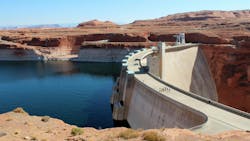Bureau of Reclamation releases Supplemental Environmental Impact Statement for Colorado River system
The Biden-Harris administration announced a milestone in its efforts to protect the stability and sustainability of the Colorado River System and strengthen water security in the West. Due to conservation investments as well as improved hydrology, Lake Mead levels today, at elevation 1,075 feet, are the highest since May 2021, when they were at 1,073 feet.
The Department of the Interior’s Bureau of Reclamation released a final Supplemental Environmental Impact Statement (SEIS) in the ongoing, collaborative effort to update the current interim operating guidelines for the near-term operation of Glen Canyon and Hoover Dams to address the ongoing drought and impacts from the climate crisis. The identified alternative reflects a historic, consensus-based proposal that will lead to at least 3 million acre-feet (maf) of system water conservation savings through the end of 2026, when the current guidelines expire.
As part of these water use reductions, the Department also announced three new System Conservation Implementation Agreements that will commit water entities in California to conserve up to 399,153 acre-feet water in Lake Mead through 2026. The Department also announced additional progress with the Republic of Mexico to conserve Colorado River System water.
Final SEIS reflects collaboration with basin states, tribes, other parties
In order to protect Glen Canyon and Hoover Dam operations, system integrity, and public health and safety through 2026 — at which point the current interim guidelines expire — an initial draft SEIS was released in April 2023. Following a historic consensus-based proposal, which committed to measures to conserve at least 3 maf of system water through the end of 2026, Reclamation temporarily withdrew the draft SEIS to allow for consideration of the new proposal. The bureau released a revised draft SEIS in October 2023 as part of the process to fully analyze this proposal.
The preferred alternative will conserve at least 3 maf of system water through the end of 2026 and allows for reducing releases from Lake Powell down to 6 maf if the reservoir is projected below 3,500 feet over the subsequent 12 months. This would be implemented across a range of elevations in Lake Mead and would be in addition to the already existing 2007 Interim Guidelines shortages and contributions under the Lower Basin Drought Contingency Plan. The Record of Decision is anticipated in the coming weeks. This announcement is the result of discussion with all parties across the Basin – including 27 nation-to-nation consultations with Tribes across the region.
The results of updated SEIS modeling indicate that the risk of reaching critical elevations at Lake Powell and Lake Mead has been reduced substantially. As a result of the commitment to record volumes of conservation in the Basin and improved hydrology, the chance of falling below critical elevations was reduced to 8% at Lake Powell and 4% at Lake Mead through 2026. However, elevations in these reservoirs remain historically low, and long-term conservation measures will still be necessary to ensure continued water delivery to communities and to protect the long-term sustainability of the Colorado River System.
Reclamation announced three new System Conservation Implementation Agreements in California that will conserve water in Lake Mead, including agreements with:
- Bard Water District, in cooperation with Metropolitan Water District: This agreement commits up to 18,090 acre-feet of conserved water through 2026;
- Coachella Valley Water District: This agreement commits up to 30,000 acre-feet of conserved water through 2026;
- Palo Verde Irrigation District, in cooperation with Metropolitan Water District: This agreement commits up to 351,063 acre-feet of conserved water through 2026;
In total, 24 conservation agreements across California and Arizona are expected to conserve up to 1.58 maf of water through 2026, with an investment of up to $670.2 million from the Inflation Reduction Act, which overall provides $4.6 billion to address the historic drought across the West. Reclamation continues to work with local partners on addition conservation agreements under development.
Through the Bipartisan Infrastructure Law, Reclamation is also investing another $8.3 billion over five years for water infrastructure projects, including water purification and reuse, water storage and conveyance, desalination and dam safety. Since the Law’s signing, the Department has provided more than $2.9 billion to fund 425 projects, including $825 million for 131 aging infrastructure projects; $377 million to 231 WaterSMART grants; $382 million for 12 water storage and conveyance projects; and $698 million to seven rural water projects.
In addition, the International Boundary and Water Commission and Reclamation are leading a complementary effort with the Republic of Mexico on additional water savings measures Mexico will implement through 2026. We continue to work bilaterally and cooperatively with Mexico as an integral part of our short and long-term planning processes for the future of this Basin.
Long-term planning continues with robust collaboration
The short-term SEIS process is separate from the ongoing long-term efforts to protect the Colorado River Basin starting in 2027. The post-2026 process currently underway is working to develop new guidelines that will replace the 2007 Colorado River Interim Guidelines for Lower Basin Shortages and the Coordinated Operations for Lake Powell and Lake Mead, which are set to expire at the end of 2026.
The post-2026 process is a multi-year effort that will identify a range of alternatives and ultimately determine operations for Lake Powell and Lake Mead and other water management actions for decades into the future. The completed draft EIS is anticipated by the end of 2024 and will include a public comment period. Reclamation anticipates a final EIS will be available in late 2025, followed by a Record of Decision in early 2026.
For the full press release, click here.






